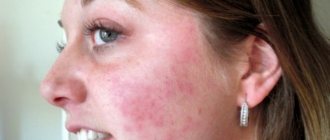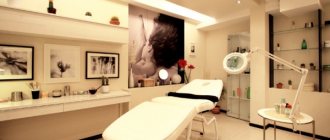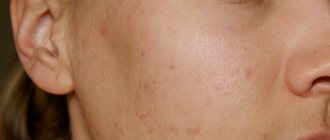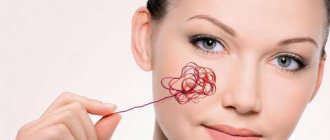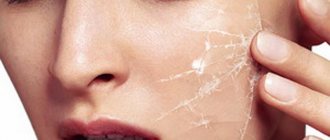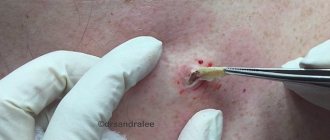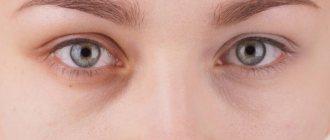Types and causes of appearance
There are several main types of scars:
- Keloids. Formed as a result of damage. Excessive amounts of collagen accumulate in the tissues, causing them to become enlarged and appear swollen. The scar can grow to a size several times larger than the area of damage, so this type is classified as a benign tumor. The color may be reddish or dark.
- Atrophic. Their occurrence is associated with the death of damaged skin cells, so they are located slightly below the main layer, resembling small depressions. Causes include acne and skin diseases. They can be colored only in the center or completely colorless and pale.
- Tightened. Appear as a result of burns. The skin in this case appears pulled toward the center, resembling folds of skin, and smoother at the edges.
- Hypertrophic. They occur after damage and as a consequence of inflammatory processes. They are often confused with keloids, since such scars also accumulate collagen and rise above the surface of the skin. But they do not tend to increase in size and smooth out over time. They appear mainly in the nasolabial folds, cheeks and mouth.
- Striae or stretch marks. This type of scar occurs when a person gains weight and then loses it quickly. Often observed in pregnant women. Externally it resembles small cracks on the surface of the skin. It has a lighter or reddish color compared to other fabrics.
The appearance of scars of this type on the face is impossible.
Why do scars appear on the face?
Acne often appears in young people between the ages of 15 and 24. After all, then hormonal changes occur in the body and are quite powerful. But there are cases when acne occurs in adults.
The following points can lead to this:
- inflammatory process on the skin;
- improper functioning of the sebaceous glands;
- many sex hormones;
- hyperkeratosis (the stratum corneum of the skin becomes much thicker);
- fat metabolism is disrupted, so pores and glands become clogged;
- diseases associated with the gastrointestinal tract;
- disorders related to the endocrine system.
In most cases, pimples appear in the wrong place and many people try to remove them. But in this way, they aggravate the problem. Scars and welts on the face often appear after a person has squeezed out a pimple on their own. After all, the blood vessel bursts, the collagen fibers are torn, but the mouth is not cleansed. And here the inflammation descends into the deeper layers, and can even cover those areas of the skin that are located nearby.
Will there be a scar where the pimple was squeezed out? It all depends on facial care, the characteristics of the body, the depth and strength of inflammation.
How can you disguise it?
Among the ways to hide scars on the skin:
- Makeup. The easiest way to make a scar less noticeable. To do this, it is important to choose a foundation that will make the color of the scar close to the skin tone. For example, if a light scar stands out against the background of tanned skin, the cream should be 2 shades darker. And if the scar is darker than the main skin tone - 2 shades lighter.
Before the procedure, the skin must be cleansed and moisturized. The foundation is applied evenly and secured with 2 layers of powder.
You should not apply a lot of cosmetics to the scar, this will only attract attention to it. You can also focus on the eyes or lips, this will distract the eyes from the defect.
- Tattoo. Not everyone will dare to take such a bold step, but today face tattoos are no longer something surprising. Before the procedure, it is better to undergo an examination and determine the type of scar. For keloids, tattoos should not be done, as this can lead to scar growth.
The scar can be made into an element of the design or simply applied paint to its surface.
Contact a specialist who has already performed a similar procedure.
Reviews
After positive therapy, many leave reviews about this or that product. Based on them, we can draw conclusions about effective procedures.
Natalya, 24 years old: There were terrible acne scars on my cheek. We managed to cope with them with the help of Contractubex. True, the treatment was carried out for a long time. But the result was pleasing: there were practically no pits left on the skin.
Christina, 30 years old: As a child, I fell, which left a scar on my skin. It had to be removed in a beauty salon using laser resurfacing. And why didn't I do this earlier?
Irina, 27 years old: I didn’t believe in the miracles of traditional medicine. But a friend advised me to eliminate a small scar on the skin with the help of badyagi and hydrogen peroxide. After some time, not a trace of the scar remained.
When and why to delete?
Scar removal is carried out according to the following indications:
- Medical. The presence of a scar interferes with the normal movement of the eyes, eyebrows, and opening of the lips. Sometimes the presence of scars, for example keloids, can pose a potential threat to human health.
- Cosmetic. Scars are unattractive from an aesthetic point of view. If they are very noticeable, a person develops complexes and may be ashamed of his appearance.
When deleting, the following features are taken into account:
- scar localization;
- presence of changes in blood vessels;
- type of mark;
- person's age;
- predisposition to skin diseases;
- state of the immune system.
The procedure must be prescribed no earlier than 1 year after the appearance of the scar. It takes time for the scar to “mature”, that is, the tissues are completely healed and removal of the mark does not lead to the appearance of skin diseases.
Salon treatments
You can get rid of formations both at home yourself and in beauty salons. The latter option is preferable if deep scars have formed on the skin. In this case, scar removal is carried out using one of the methods given below. It is selected depending on the nature and depth of skin damage.
Chemical peeling is an aggressive action on the facial skin with chemical acids. For different formations, a median or superficial procedure is prescribed.
Laser resurfacing helps to painlessly cleanse the skin
During exposure, dead skin cells are removed. As a result, the integument is leveled, and new tissue begins to form in the treatment area. The procedure is strong, but at the same time effective. It can only be done in a cosmetologist’s salon.
Laser treatment can also cleanse the skin, similar to a chemical peel. The only difference is the use of special rays to remove the superficial stratum corneum.
Is it possible to get rid of it completely?
The hardest scars to remove are those that occurred in childhood. A good result can only be achieved by contacting a plastic surgeon. The use of cosmetic procedures will make the scar more aesthetically pleasing and less eye-catching. Scars that are no more than 3 years old are much easier to remove.
It should also be taken into account that the smaller the defect, the easier it is to remove. Small marks can be removed even at home using traditional methods.
But regardless of the removal method, the following aspects are taken into account:
- Patience. Don't expect an immediate effect. Even a small scar can take several years to remove.
- Responsibility. It is better to discuss treatment methods with your doctor. Carefully follow all recommendations.
Types of scars
The scar remains in the area of the skin where it was most damaged. Experts divide scars into several types:
- normotrophic scars (they are not corrected, because they are barely noticeable);
- atrophic;
- hypertrophic;
- keloids.
Usually people develop atrophic variants of scars. These are depressions with chipped or rounded edges. They occur when there is not enough collagen in the body. Hypertrophic scars are more dense; they rise above the skin because the collagen has not had time to dissolve. But keloid scars are considered the most difficult. Here the connective tissue grows strongly, it covers even those areas of the skin that have not been damaged. These scars are reddish in color and quite rough.
Removal methods
There are several ways to get rid of a scar on your face.
Laser resurfacing
It involves using a laser to stimulate the cell restoration process.
There are 2 options for the procedure:
- Classic. The procedure is carried out by drying the tissue and resorption of collagen. Afterwards, the layer of dead cells is easily removed. More suitable for keloid and hypertrophic types.
- Factional. In the process, on the contrary, the production of collagen is launched, which helps restore the skin with atrophic and tight scars.
Should not be carried out when:
- bearing a child;
- diabetes;
- skin diseases;
- cancerous tumors.
The effect will be noticeable after the 1st procedure. But to achieve a good result, it is better to attend 5-10 procedures, taking breaks for 1-2 months.
Plasmolifting
During the procedure, blood is taken from a person, from which, after special processing, platelet-rich plasma is released. Using an injection, it is injected under the skin in and around the scar.
The advantages are:
- painlessness;
- no side effects;
- preventing the reappearance of scars.
Contraindicated for:
- skin diseases;
- oncology;
- mental disorders.
On average, 5 procedures are required to obtain a good result.
Chemical peeling
The skin is burned with acid. Before the procedure, you need to thoroughly cleanse your facial skin and remove makeup. A chemical is applied to the skin, which is removed after a few minutes. After some time, the skin becomes crusty and peels off, replaced by a new, healthier one.
The main advantage is the smoothing of tissues. The color of the scar approaches the skin tone.
It is prohibited to carry out:
- pregnancy;
- proneness to allergies;
- many moles;
- cardiovascular diseases;
- tan
A total of 2-3 procedures are performed with a break of 14 days.
Injection correction
The method of injection removal is mesotherapy. Vitamin cocktails are injected under the skin of the scar and around it. Skin enriched with useful substances recovers faster.
Allows you to achieve quick and lasting results.
Negative aspects are the appearance of swelling and changes in skin color after the procedure.
You should not:
- pregnant and lactating women;
- minors;
- for inflammation and infections;
- with poor blood clotting.
Usually up to 10 procedures are required.
Enzyme correction
More suitable for keloid and hypertrophic scars. Enzymatic substances are injected under the skin, which destroy excess collagen and help smooth the tissue.
The procedure is prescribed only after an individual consultation.
Microdermabrasion
In other words, mechanical peeling. The top layer of cells is removed using a microcrystalline attachment. Helps cope with hypertrophic and keloid type scars.
The main disadvantage of the procedure is its high pain.
Prohibited when:
- epilepsy;
- tanning;
- inflammation;
- diabetes
You will need to attend 10-12 sessions with a break of 14 days.
Cryotherapy
Indicated in the presence of keloid and hypertrophic scars. In the process, the rumen is exposed to a solution of liquid nitrogen. Freezing will improve blood circulation, which improves tissue nutrition and healing.
Cannot be used in cases:
- pregnancy;
- sensitivity to cold;
- tendency to bleed.
The advantage of cryotherapy is the low risk of infection getting under the skin.
To achieve the effect, you need to attend 8-10 procedures, taking breaks for 3 weeks.
Surgical intervention
There are several methods for surgically removing scars:
- Skin grafting. It is performed if large areas of facial skin are affected. In this case, the scarred tissue is removed and healthy tissue is transplanted in its place. After the procedure, the patient needs special care, since the new skin may not take root.
- Excision. If the scar is not very large, it is removed with a scalpel, and the skin along the edges is carefully sewn together with a cosmetic suture. A small scar remains, which can be removed with cosmetic methods.
- Smoothing. Bags with a special liquid are placed under the skin of the scar, the volume of which gradually increases until the skin is smoothed. Then the bags are removed. Helps fight atrophic scars.
Contour plastic
The process involves introducing hyaluronic acid under the skin of the scar. Collagen production processes are stimulated and tissues are smoothed. Effective for atrophic lesions. It has almost no contraindications. The negative point is that the effect lasts up to 1 year and a repeat injection is required.
Undercutting
Another way to eliminate atrophic scars. With the help of a special needle, the bottom of the scar is injured, as a result of which a new layer of connective tissue appears at the site of damage, which lifts the skin.
The number of procedures depends on the size of the scar; up to 3 operations may be required with breaks of 1.5 months.
Use of ointments, gels, creams
You can soften scarred skin using special products:
- Curiosin. Contains zinc hyaluronate. Promotes tissue restoration, disinfects and relieves inflammation. With its help you can get rid of small scars.
- Contratubeks. A gel that can be used to improve the condition of tissues. It must be used up to 4 months. After application, allow the product to absorb and remove any remaining residue with a damp cloth.
- Mederma. Has softening properties. Apply to the skin 2 times a day until completely absorbed. The course lasts 6 months.
- Fermenkol. Smoothes the skin with hypertrophic and keloid scars. It is distributed on the integument in a thin layer. Use for 1 month.
Folk remedies
You can remove small scars using the following recipes:
Mask with lemon and aloe. How to do:
- take 1 fleshy aloe leaf;
- grind thoroughly;
- squeeze out the juice;
- add the same amount of lemon juice.
Apply the finished product to the scar using a cotton swab. Rinse off with warm water after 20 minutes.
Essential oils. Instructions:
- take 5 ml each of rosemary, nerola and mint oils;
- mix.
Apply the product to the scar 2-3 times every day.
Cabbage mask. Procedure:
- take white cabbage leaves;
- grind in a blender until you get a paste;
- add 1 tbsp. l. honey;
- stir.
Apply the mask to the scar, cover with a layer of gauze. Wash off after 2 hours.
Herbal collection. What do you need:
- take 1 tsp. nettle, St. John's wort, oregano, chamomile, knotweed, calendula;
- mix;
- 1 tbsp. l. pour 300 ml of boiling water;
- leave for 1 hour.
Apply a cotton pad soaked in the infusion to the scar 2-3 times a day.
Treatment methods for atrophic scars on the face
Atrophic scars on the face are a skin defect that does not go away on its own. If you neglect the necessary treatment, unpleasant scar marks will remain forever. Medical intervention through medications must be carried out under the supervision of a specialist. All means and preparations are selected depending on the type and stage of damage. Today there are many treatment options.
If atrophic scars are at the final stage of development, then drug therapy will be ineffective. In this case, you can resort to cosmetic correction of scars. It includes skin smoothing, regulation of color and texture of damage.
So, removal of atrophic scars on the face is performed using the following procedures:
- Filler injections;
- Hardware leveling;
- Surgical excision.
Physiotherapy should be individualized. To a greater extent, it will depend on how long ago atrophic scars formed on the face.
The sooner you start treatment, the easier it will be to get rid of the scar. But you shouldn't expect instant results. Skin restoration can take more than one year.
Recommended articles on the topic:
- Facial mesotherapy procedure: pros and cons
- Beauty injections: types of drugs, reviews
- Placental therapy is the secret of eternal youth
Injection methods
Small atrophic scars located linearly on the face can be easily eliminated with “beauty injections.” The most common correction methods:
- mesotherapy;
- biorevitalization;
- facial contouring.
Mesotherapy is the introduction of meso-cocktails under the scars, the composition of which contains vitamin complexes, homeopathic substances and various medications.
These solutions lift the scar layer of the skin and activate the natural production of collagen.
Biorevitalization is an injection of hyaluronic acid into atrophic areas of the skin.
The procedure is performed only in combination with laser resurfacing. Without the intervention of a laser, it will not be possible to achieve the desired result.
Removing atrophic scars on the face using contour plastic surgery means filling the scars with gel preparations or fillers.
The most popular products are Juvederm, Restylane and Collost. A good result can be obtained only after three or four injections. The procedure itself is quite expensive and does not provide long-lasting results. After 10–12 months, you will need to resort to plastic surgery again.
Read material on the topic: Laser biorevitalization of the face without complications and side effects
Hardware cosmetology
Atrophic scars can be corrected using special devices. These devices are more productive than injections, but they cannot completely remove traces of skin damage.
To obtain the best effect from the treatment of atrophic scars on the face, you can resort to microcurrent therapy. This will improve the healing process, lymphatic drainage and metabolism in the scar layer. A good result can be obtained by attending 6–8 therapy sessions.
Atrophic scars in the last stages are removed using the following procedures:
- microdermabrasion;
- laser resurfacing;
- fractional photothermolysis.
Each technique has its own pros and cons. Microdermabrasion is an excellent treatment option for treating moderate to severe facial damage. The procedure is aimed at evening out skin color and smoothing out scars. The effect is achieved after ten visits to a specialist.
Laser resurfacing helps in getting rid of post-acne. Also, as a result of therapy, the natural production of collagen is activated, bringing the bottom of the lesion closer to the surface of the skin. However, for large areas of damage, this procedure will be very painful. The rehabilitation period will last at least a month, and full recovery can be expected in six months. Removing small scars will be less traumatic.
Atrophic scars on the face are best removed by fractional photothermolysis. The basis of the procedure is laser resurfacing, but the difference from the previous method is that not all of the skin is damaged, but only 20–25%.
Photothermolysis is less painful than full laser treatment. Recovery takes 14–20 days.
Scar excision
Deep atrophic scars on the face can only be treated with surgery. The operation is based on excision of connective tissue. This is a very painful process, so the procedure includes a long rehabilitation period. The operation takes place under general anesthesia over several hours. The full effect will be noticeable after 8-9 months.
Surgical excision of linear scars is a fairly expensive procedure. Removing a scar up to 5 cm costs about 10 thousand rubles.
In case of deeper injuries, the operation includes cutting (subcision) of the skin tissue. Using a special needle, the bottom of the fireplace is pryed up and raised. Visually, the effect is very noticeable, but in the future, smoothing of the skin may be necessary.
Creams and ointments
Atrophic scars on the face can be treated at home. The therapy is based on ointments containing silicones and plant extracts. They are applied to the affected areas.
The type of cream is selected by a dermatologist. They must take into account factors such as the causes of damage, the type and stage of scar formation.
Most often, a specialist prescribes agents that have an anti-inflammatory and antibacterial effect. They help liquefy wounds, improve blood circulation and increase local immunity.
Ointments can be used to enhance the effect of hardware therapy.
Read material on the topic: How to care for facial skin: home care and salon treatments
Rehabilitation period
During the recovery process after facial scar removal, you should not do the following:
- use cosmetics containing alcohol and decorative cosmetics;
- treat the skin with cleansers;
- be exposed to hot water or steam;
- perform active physical exercise, since particles of sweat can get into the scar;
- remove the crust formed after the procedures;
- stay in the sun for a long time.
You need to use facial moisturizers more often. Sometimes antibiotics are required.
How to remove it from a child?
Children have more delicate skin, so most cosmetic procedures are contraindicated for them. The use of surgical methods is also possible only in extreme cases, for example, with severe burns to the face.
Therefore, it is better to use traditional medicine methods, gels and ointments. In adolescence, you can undergo cleansing with peeling. But before doing this, be sure to consult a doctor.
Children's skin requires special care, so care should be taken to treat damage in advance to prevent scars from appearing in the future.
Folk remedies
Not only expensive ointments, but also folk remedies help to cope with scars. You can perform facial cleansing treatments at home.
Face masks are considered effective. They can be prepared from various ingredients.
Essential oils are used to normalize metabolic processes. They help soften scars and eliminate the inflammatory process.
Wound healing occurs with the help of cabbage leaves. The crushed vegetable is mixed with a spoon of honey and applied to the scar area three times a day.
At home, masks made from natural ingredients are effective.
You can restore the skin with apple cider vinegar diluted with water. For three tablespoons of liquid you need to take a spoonful of the substance. After this, the solution is frozen in an ice container. The cubes can be used to wipe the skin.
After the inflammation in the scar area has ended, you can use self-prepared scrubs. To cleanse the skin it is recommended to use:
- sea salt mixed with cleanser;
- crushed oatmeal with kefir;
- badyagu diluted with hydrogen peroxide.
Folk remedies can provoke an allergic skin reaction. It is important to first test the composition in the wrist area.
After undergoing salon procedures, many are satisfied with the results
How to prevent education?
Some ways to avoid facial scars include:
- Proper nutrition. Eating large amounts of fatty and fried foods leads to an increase in the production of subcutaneous fat. The skin becomes dirty and becomes fertile ground for the development of infection and acne. The result of this process is the appearance of atrophic scars.
- Complete care. You should properly care for your skin, use moisturizers and cleansers, and perform hygiene procedures.
After burns, insect bites, and cuts, disinfectants and healing agents should be applied to the skin. If necessary, consult a doctor. He will give recommendations on what products can be used to avoid scarring.
- Safety. You need to constantly take care of protecting your facial skin, especially for those who work in production. In hot weather, it is better not to stay in the sun for a long time.
- Drinking regime. A person needs at least 1.5 liters of water per day. This promotes active nutrition and smoothing of the skin.
- The right choice of funds. When choosing facial care cosmetics, it is better to seek advice from a cosmetologist and not experiment with cheap products of dubious production.
There are 4 types of scars that can appear on the face. They can be masked or removed. But before using any method, you should undergo a full examination and obtain the advice of a specialist. This is the only way to reduce the defect on the skin.
Right way of life
How to treat scars and scars on the face? It is also worth thinking about your bad habits, lifestyle, etc. After all, even such simple moments affect the skin and its condition. For example, play more sports, lead an active lifestyle, give up bad habits, and sleep enough time so that your body has time to recover. In addition, you should watch your diet and avoid stressful situations. Following these simple rules will help avoid the appearance of acne, and as a result, scars.
